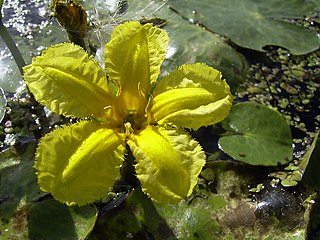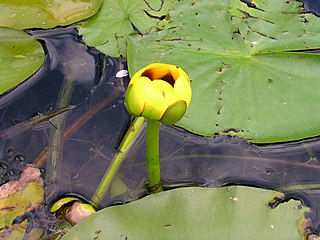
Nuphar is a genus of aquatic plants in the family Nymphaeaceae, with a temperate to subarctic Northern Hemisphere distribution. Common names include water-lily, pond-lily, alligator-bonnet or bonnet lily, and spatterdock.

Echinodorus cordifolius, the spade-leaf sword or creeping burhead, is a species of aquatic plants in the Alismatales. It is native to Mexico, the West Indies, Central America, South America and the southeastern United States.

Nepenthes rigidifolia is a critically endangered tropical pitcher plant endemic to Sumatra, where it grows at elevations of 1000–1600 m above sea level.

Nuphar lutea, the yellow water-lily, brandy-bottle, or spadderdock, is an aquatic plant of the family Nymphaeaceae, native to northern temperate and some subtropical regions of Europe, northwest Africa, and western Asia. This species was used as a food source and in medicinal practices from prehistoric times with potential research and medical applications going forward.

Nymphoides peltata is perennial, rooted aquatic plant with floating leaves of the family Menyanthaceae.

Cryptocoryne beckettii, also known as Beckett's water trumpet, is a plant species belonging to the Araceae genus Cryptocoryne.

Potamogeton natans, commonly known as broad-leaved pondweed, floating pondweed, or floating-leaf pondweed, is an aquatic species in the genus Potamogeton native to quiet or slow-flowing freshwater habitats throughout the Holarctic Kingdom.

Nuphar polysepala, also known as the great yellow pond-lily, wokas, or wocus, is a species of Nuphar native to western North America. It is commonly found in shallow muddy ponds from northern Alaska and Yukon southward to central California and northern New Mexico, and can be recognized easily by its large floating leaves and bright yellow blossoms.
Eleocharis confervoides is a species of plant in the sedge family (Cyperaceae). It is a perennial, submerged, aquatic and deeply rooted herb. It is known by its common name Algal bulrush and has lots of synonyms. The species has worldwide but very spotty distribution and is native in many tropical and subtropical regions in America, Asia and Africa. It inhabits in water, usually in shallow or deep lakes and ponds. The plant has slender stem with many branches, the leaves float in the water and flowers are usually emergent over the water surface. Fruiting occurs in fall. The most occurrences of plant appear in April and frequency of occurrences is increasing the last years

Nuphar microphylla is a perennial, rhizomatous, aquatic herb found in North America. It is listed as a special concern and believed extirpated in Connecticut.

Nuphar subintegerrima is a species of rhizomatous aquatic plant endemic to Japan.

Nymphaea loriana is a species of waterlily endemic to Manitoba, and Saskatchewan, Canada.
Nuphar ulvacea is a species of rhizomatous aquatic plant native to the US-American states Alabama and Florida.

Nuphar submersa is a species of rhizomatous aquatic plant endemic to Japan.
Nuphar orbiculata is a species of rhizomatous aquatic plant native to the US-American states Alabama, Florida, and Georgia.

Nuphar oguraensis is a species of rhizomatous aquatic plant endemic to Japan.

Nuphar × rubrodisca is a species of rhizomatous aquatic plant native to Canada and the USA. It is a natural hybrid of Nuphar variegata and Nuphar microphylla.

Nuphar × fluminalis is a species of rhizomatous aquatic plant endemic to Japan. It is a natural hybrid of Nuphar japonica and Nuphar submersa.

Nuphar pumila subsp. sinensis is a subspecies of Nuphar pumila native to China.

Nuphar sect. Nuphar is a section within the genus Nuphar native to Eurasia, in addition to a single north American species Nuphar microphylla.















